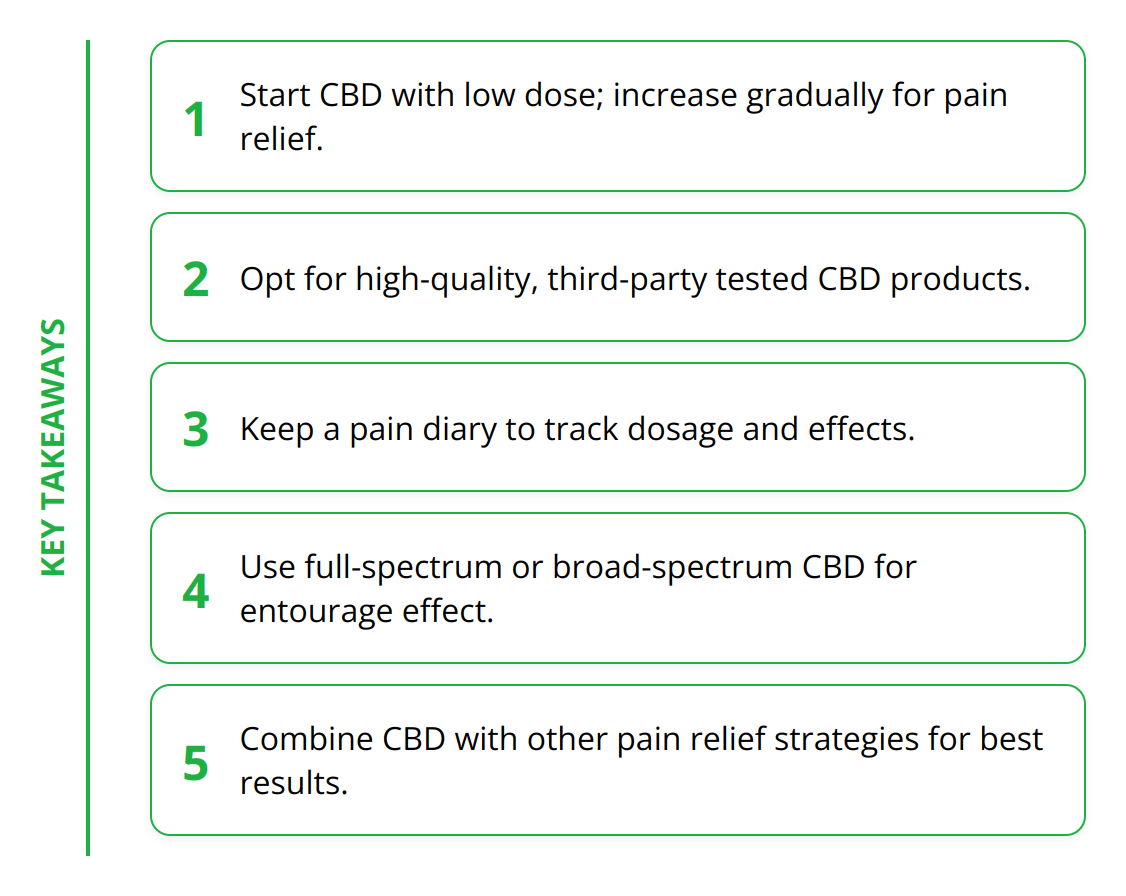We at Pure Hemp Essentials understand the profound impact chronic pain can have on daily life. CBD has emerged as a promising solution to manage this relentless discomfort. Through this guide, you’ll gain insights into how CBD works for pain relief and how to effectively incorporate it into your pain management strategy. Join us as we explore the potential of CBD to improve quality of life for those dealing with chronic pain.
Exploring CBD for Pain Relief
Cannabidiol, commonly known as CBD, is a compound found in the cannabis plant distinct from its more famous counterpart, THC. Unlike THC, CBD does not produce a “high” effect, making it an attractive option for those seeking pain relief without the psychoactive properties of marijuana. The interest in CBD as a potential remedy for chronic pain has surged, backed by growing anecdotal evidence and a slowly expanding body of scientific research.
At the heart of its effectiveness, CBD interacts directly with the human body’s endocannabinoid system (ECS). The ECS plays a crucial role in regulating various bodily functions, including pain sensation, immune response, and inflammation. By influencing the activity of receptors in the ECS, CBD can help modulate pain and inflammation, offering relief to those suffering from chronic pain conditions.
Comparatively, THC also interacts with the ECS but in a way that induces psychoactive effects alongside pain relief. This distinction is critical for individuals looking for pain solutions without the mind-altering experiences associated with cannabis.
One of the significant advantages of CBD over THC in pain management is its minimal side effects and the absence of a “high” feeling. This makes CBD a suitable option for long-term use, especially for those with chronic conditions who need consistent relief without cognitive disruption.
For practical guidance on incorporating CBD into your pain management regime, consider the following:
-
Start with a low dose and gradually increase until you find the most effective dose for your pain relief.
-
Opt for high-quality, third-party tested CBD products to ensure purity and potency. Product quality can significantly impact effectiveness.
-
Keep a pain diary to track your dosage, timing, and the effects of CBD on your pain levels. This can help you fine-tune your approach to CBD use.
Individuals have reported varying degrees of success using CBD for different types of chronic pain, including arthritis, fibromyalgia, and neuropathic pain. However, the experience can be highly individualistic, and what works for one person may not work for another.
For those considering CBD for pain management, it’s essential to consult with a healthcare provider. This is particularly vital if you’re taking other medications, as CBD may interact with certain drugs.

Further reading on managing pain and enhancing wellness with CBD can be found here and here, providing deeper insights into the benefits of CBD not just for pain, but for overall health and wellbeing.
In summary, CBD offers a promising alternative for individuals seeking relief from chronic pain. Its interaction with the body’s endocannabinoid system and its ability to offer relief without inducing a high make it an attractive option in pain management strategies. However, quality and consistency are key to achieving the best results, underlining the importance of choosing reputable products and consulting with healthcare professionals.
Selecting CBD Products for Pain
When integrating CBD into your chronic pain management strategy, the sheer diversity of available products can be overwhelming. Understanding the different forms of CBD and knowing what to look for in high-quality products are paramount steps towards achieving relief. Here’s a practical guide to navigate through the options and make informed decisions.
Understanding CBD Varieties
CBD products come in various forms, each with its unique advantages. Oils and tinctures are popular for their ease of dosage and quick absorption when placed under the tongue. These are ideal for consistent, everyday use. Topicals, such as creams and balms, are applied directly to the skin, offering targeted relief to pain areas, making them perfect for localized joint or muscle pains. Edibles, like gummies, provide a convenient and discreet way to consume CBD, though they may take longer to take effect. Lastly, capsules offer the simplest form of dosage but also require time to pass through the digestive system.

Factors to Consider
Choosing the right CBD product hinges on several factors. First and foremost, consider the type of pain you’re experiencing. For widespread pain, oils or capsules may provide more systemic relief, while topicals are better suited for specific, localized discomfort.
Secondly, the concentration of CBD matters. Products with higher concentrations may offer more pronounced effects, but it’s wise to start with a lower dose and gradually increase it to find what works best for your body.
Third-party testing is another critical factor. Reputable products will have a Certificate of Analysis (COA) that confirms their CBD content and purity. This transparency is a hallmark of quality and safety.
Tips for High-Quality CBD Products
-
Look for full-spectrum or broad-spectrum on labels. These extracts contain a range of cannabinoids and compounds that work together to enhance health benefits, a phenomenon known as the entourage effect.
-
Check the source. High-quality CBD is derived from organically grown hemp, free from pesticides and harmful chemicals.
-
Examine lab reports. Always opt for brands that provide transparent access to third-party lab results, verifying the product’s CBD content and purity.
-
Read reviews and testimonials. Genuine customer feedback can offer insights into the efficacy and quality of the product.
Exploring the right CBD product for your unique needs can be a journey, but armed with the proper knowledge, you can make an informed choice. Whether you opt for an oil, topical, edible, or capsule, the goal is to manage pain effectively and enhance your overall quality of life. Dive deeper into tips for enhancing health with CBD gummies and discover how to incorporate CBD into your daily routine for sustained wellness.
Navigating CBD Dosage for Pain
Finding the optimal CBD dosage for chronic pain can seem daunting, but it’s achievable with the right approach. The key is to start low and go slow, allowing your body to adjust while finding the dose that provides the relief you’re seeking. Here’s how to tackle this:
Initially, beginning with a small dose, such as 5-10 mg of CBD once or twice a day, is advisable. Observing how your body responds over a week, you can gradually increase the dose by 5-10 mg per week until you reach a point where you experience significant pain relief without adverse effects.
It’s important to note that CBD’s effects can vary depending on several factors, including body weight, the nature of the chronic pain, and individual body chemistry. Therefore, a dose that works for one person might not work for another.
Administering CBD Effectively
CBD oils or tinctures are popular for pain management due to their flexibility in dosing and rapid absorption when applied under the tongue. They allow for precise dosage adjustments, which is essential in finding your optimal dose.
Topicals, applied directly to the skin over painful joints or muscles, can provide localized relief. These are best for localized pain and may need to be used in conjunction with other forms of CBD for comprehensive pain management.
Edibles and capsules, while offering the convenience of pre-measured doses, may take longer to show effects due to the digestion process. They could be more suitable for maintaining long-term, sustained relief throughout the day.

Tracking Your CBD Use and Pain Levels
Keeping a detailed record of your CBD usage and its effects on your pain levels is crucial. Record the dosage, the time of consumption, and any changes in your pain intensity or side effects. This log will help you fine-tune your dosage and method of administration to better suit your needs.
Combine CBD with Other Pain Relief Strategies
While CBD can offer significant relief, it’s often more effective when part of a broader pain management strategy. This may include physical therapy, exercise, heat and cold therapy, or other natural supplements. Always discuss new treatments or supplements with your healthcare provider, especially if you’re on other medications.
Here are additional tips for optimizing your use of CBD for chronic pain:
-
Stay hydrated, as CBD and other pain management strategies can affect your hydration levels.
-
Maintain a healthy diet to support overall health and enhance CBD’s effectiveness.
-
Consider practicing mindfulness or relaxation techniques to reduce stress and improve pain management.
For more insights, explore how to enhance your focus with CBD.
In summary, finding the right CBD dosage and method of administration requires patience and careful monitoring. By starting with a low dose and slowly increasing, paying close attention to how your body responds, and integrating CBD into a comprehensive pain management plan, you can navigate your way to effective chronic pain relief.
Final Thoughts
Exploring CBD for chronic pain relief opens a new chapter for many in their wellness journey. Through this guide, we’ve highlighted how CBD engages with the body’s endocannabinoid system to potentially ease pain and inflammation. Remember, starting with a low dose and gradually finding what works best for your body is key to utilizing CBD effectively.

Quality and consistency are crucial in selecting CBD products. For targeted pain relief or general wellness, choosing the right form, whether it be oils, topicals, edibles, or capsules, plays a significant role in the effectiveness of your treatment. Always opt for products that are third-party tested to guarantee purity and potency. For a selection of high-quality CBD products, consider exploring Pure Hemp Essentials.
Managing chronic pain is deeply personal, and what may work for one individual could vary for another. Thus, keeping a detailed record of your CBD usage and its impact on your pain levels can guide you to a more tailored and effective approach. Moreover, integrating CBD into a broader pain management strategy can enhance your quality of life.
Continued research into CBD and its potential benefits is vital, and staying informed on the latest findings can help you make educated decisions about your pain management plan. Consulting with healthcare providers before starting or adjusting your CBD usage ensures safety, especially if you’re taking other medications.
As the landscape of chronic pain management evolves, CBD stands out as a promising and natural alternative. Its potential to offer relief without the psychoactive effects associated with other pain relief methods makes it an attractive option for many. Here at Pure Hemp Essentials, we’re optimistic about the future of CBD in pain relief and overall wellness. We’re committed to providing you with the highest quality products to support your health journey.
Embracing CBD for chronic pain relief is a step toward reclaiming control over your well-being. With an informed approach and ongoing consultation with healthcare professionals, CBD can be a valuable addition to your pain management strategy.
